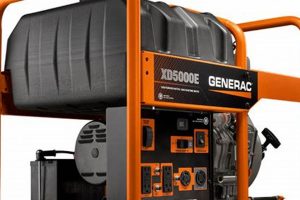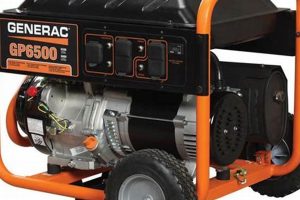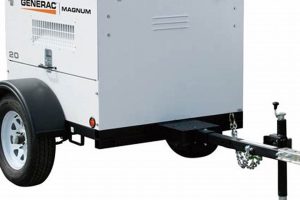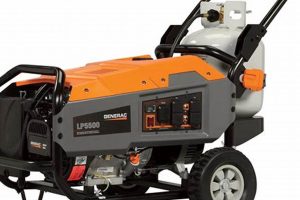This specific model provides a substantial power output of 8000 watts (running) and 10000 watts (starting), making it suitable for a variety of applications, from powering essential household appliances during outages to providing electricity for job sites, recreational activities, and more. Its portability, facilitated by integrated wheels and a handle, allows for easy transport to where power is needed. Electric start functionality simplifies operation.
Reliable backup power solutions are critical for maintaining essential services during unforeseen events. Power outages caused by severe weather, grid failures, or other disruptions can significantly impact homes, businesses, and communities. Having access to a robust, portable power source provides continuity for crucial systems, appliances, and devices, ensuring safety and minimizing disruption. Such units also offer convenient electricity access in locations where conventional power is unavailable, supporting professional work, leisure activities, and emergency response efforts. Advances in generator technology have resulted in quieter, more fuel-efficient models offering cleaner power, making them an increasingly valuable resource.
Further exploration of this power solution will cover key features, technical specifications, proper operation procedures, safety considerations, maintenance requirements, and potential applications. Understanding these aspects is vital for safe, efficient, and effective utilization.
Operating Tips for Portable Generators
Safe and efficient operation of portable generators requires adherence to specific guidelines. These tips emphasize best practices for optimal performance and user safety.
Tip 1: Proper Grounding is Essential: Always ground the unit according to manufacturer instructions. This critical step prevents electrical shock hazards.
Tip 2: Never Operate Indoors: Generators produce carbon monoxide, a colorless, odorless, and deadly gas. Operate only in well-ventilated outdoor locations, far from windows, doors, and vents.
Tip 3: Allow the Engine to Cool: Before refueling, always allow the engine to cool completely. Hot engine components can ignite fuel vapors.
Tip 4: Use Appropriate Extension Cords: Employ heavy-duty, outdoor-rated extension cords with sufficient capacity for the connected load. Undersized cords can overheat, posing a fire risk.
Tip 5: Regular Maintenance is Crucial: Adhere to the manufacturer’s recommended maintenance schedule. Regular oil changes, air filter cleaning, and spark plug replacement ensure optimal performance and longevity.
Tip 6: Protect From the Elements: When not in use, store the generator in a dry, protected location to prevent corrosion and damage.
Tip 7: Fuel Storage Safety: Store fuel in approved containers, away from ignition sources. Never refuel a running or hot generator.
Adhering to these guidelines ensures safe, reliable operation and prolongs the lifespan of the equipment. Neglecting these precautions can result in equipment damage, personal injury, or even fatality.
Understanding proper operating procedures is crucial for utilizing portable generators effectively. The subsequent sections will delve into specific technical specifications and further safety considerations.
1. Power Output
Power output represents a critical characteristic of any generator, directly influencing its capacity to operate various devices. Understanding the power output specifications of the Generac XT8000E is crucial for ensuring its effective utilization and preventing potential damage to connected equipment.
- Running Watts:
Running watts refers to the continuous power supply the generator can provide. The Generac XT8000E offers approximately 8000 running watts, sufficient for powering essential household appliances like refrigerators, sump pumps, and lighting circuits during an outage. Accurately estimating the running wattage requirements of intended loads is essential for avoiding generator overload.
- Starting Watts (Surge Watts):
Starting watts, also known as surge watts, represents the higher power output briefly available for starting motor-driven appliances. These appliances, such as air conditioners and power tools, require a surge of power for initial motor engagement. The Generac XT8000E provides around 10000 starting watts, accommodating the increased power demand during appliance startup.
- Wattage Requirements of Appliances:
Each appliance possesses specific wattage requirements. Consulting the appliance’s documentation or data plate reveals its running and starting wattage needs. Calculating the cumulative wattage requirements of all intended loads ensures the chosen generator’s capacity aligns with the demand. Overloading the generator can lead to damage and potential safety hazards.
- Power Management:
Effective power management optimizes generator utilization. Prioritizing essential loads and staggering the operation of high-wattage appliances prevents overloading the generator. Power management strategies ensure continuous operation of critical devices during extended outages.
Matching the Generac XT8000E’s power output capabilities with the specific power demands of intended applications ensures reliable operation and prevents equipment damage. Careful consideration of running watts, starting watts, and power management techniques maximizes the generator’s effectiveness as a dependable power source.
2. Portability
Portability represents a defining characteristic of the Generac XT8000E, significantly influencing its practical applications and overall utility. The unit’s portability stems from a combination of design features, enabling convenient transport and deployment in diverse scenarios. Integrated wheels and a folding handle facilitate movement across various terrains, while its compact dimensions contribute to manageable handling.
This portability expands the generator’s usability beyond stationary backup power for homes. Construction sites benefit from a readily available power source for tools and equipment. Outdoor events and recreational activities gain access to electricity in remote locations. Emergency response scenarios utilize portable generators to power essential equipment in disaster-stricken areas. The ability to easily transport the Generac XT8000E amplifies its value across these diverse applications.
However, the weight of the unit remains a consideration. While designed for portability, the Generac XT8000E possesses substantial mass. Users must assess their individual lifting capabilities and consider utilizing ramps or other assistance when moving the generator across uneven terrain or onto elevated surfaces. Proper lifting techniques and adherence to safety precautions mitigate potential strain or injury. Understanding the practical implications of the generator’s weight ensures safe and effective transport.
3. Fuel Type
The Generac XT8000E typically operates on gasoline. This fuel choice impacts several operational aspects, including runtime, maintenance requirements, and environmental considerations. Gasoline offers widespread availability, making refueling relatively convenient. However, gasoline storage necessitates adherence to safety regulations due to its flammability. Properly sealed containers, stored away from ignition sources, are essential. Fuel stabilizer use can prolong storage life and prevent carburetor issues. The combustion process generates emissions, necessitating operation in well-ventilated areas. Understanding the implications of gasoline as a fuel source contributes to safe and responsible generator operation.
Runtime depends on fuel tank capacity and engine load. Higher loads consume fuel more rapidly, reducing overall runtime. Monitoring fuel levels and refueling as needed ensures uninterrupted power supply during extended outages. Regular maintenance, including oil changes and air filter cleaning, optimizes engine performance and fuel efficiency. Neglecting maintenance can lead to increased fuel consumption and potential engine damage. Considering fuel consumption rates and maintenance schedules facilitates effective planning and cost management.
While gasoline offers convenience and readily available infrastructure, alternative fuel options might offer distinct advantages in specific situations. Propane, for example, offers extended storage stability and cleaner combustion. Exploring alternative fuel options and conversion possibilities can provide valuable insights for users seeking different operational characteristics or environmental impact reductions. Understanding the trade-offs between fuel types empowers informed decisions based on individual needs and priorities.
4. Starting Mechanism
The starting mechanism of the Generac XT8000E plays a crucial role in its usability, impacting the speed and ease with which the generator can be brought online. A reliable and convenient starting system is particularly critical during emergency situations where rapid access to power is essential. Understanding the starting mechanism’s functionality allows for efficient operation and informed troubleshooting should issues arise.
- Electric Start
The Generac XT8000E features an electric start system, activated by a simple turn of a key or push of a button. This method offers significant convenience, eliminating the physical effort associated with recoil starting. Electric starters are particularly beneficial in cold weather conditions or for individuals with physical limitations. A functioning battery is crucial for the electric start system. Regular battery maintenance, including charging and terminal cleaning, ensures consistent starting reliability.
- Recoil Start (Backup)
While the primary starting method is electric, many portable generators include a recoil start as a backup option. This manual starting method utilizes a pull cord to initiate the engine. Understanding the recoil start procedure provides an alternative starting method should the electric start fail due to a dead battery or other electrical issues. Familiarity with the recoil starting technique ensures operational redundancy.
- Battery Maintenance
Battery health directly impacts the reliability of the electric start system. Periodic battery charging, particularly during periods of extended storage, prevents battery discharge and ensures starting capability when needed. Regular inspection of battery terminals for corrosion and cleaning as necessary maintains optimal electrical connections. Proper battery maintenance practices contribute significantly to consistent starting performance.
- Troubleshooting Starting Issues
Occasional starting difficulties can occur. Systematic troubleshooting procedures help identify the underlying cause. Checking the fuel level, ensuring the fuel valve is in the correct position, and inspecting the spark plug are initial steps. If the electric start fails, attempting the recoil start can help determine if the issue lies with the electrical system or the engine itself. Consulting the owner’s manual for specific troubleshooting guidance provides detailed information for resolving starting problems.
The starting mechanism’s reliability significantly impacts the overall dependability of the Generac XT8000E as a power source. Regular maintenance and familiarity with both electric and recoil starting procedures contribute to efficient operation and minimize potential disruptions during power outages or other critical situations. Understanding these components enhances the user’s ability to effectively utilize and maintain the generator.
5. Outlets/Connections
The available outlets and connection options on the Generac XT8000E portable generator directly influence its versatility and compatibility with various electrical devices. Understanding these connection points is crucial for safe and effective power distribution. Mismatched connections or improper usage can lead to equipment damage or safety hazards.
- Variety of Outlets
The Generac XT8000E typically features a range of outlets designed to accommodate different plug types and amperage requirements. These may include standard household outlets (120V), as well as higher-voltage outlets (240V) for powering larger appliances or tools. This variety expands the range of devices compatible with the generator, enhancing its utility in diverse applications. Careful attention to the voltage and amperage ratings of each outlet is essential for preventing damage to connected equipment.
- Twist-Lock Outlets
Twist-lock outlets provide a more secure connection compared to standard household outlets. These specialized outlets are designed to prevent accidental disconnection, particularly in demanding environments like construction sites or outdoor events where cords may be subject to movement or vibration. Their robust design enhances safety and reliability in challenging operating conditions.
- Circuit Breakers
Integrated circuit breakers play a crucial safety role, protecting both the generator and connected devices from overloads. These breakers automatically interrupt the flow of electricity in the event of a short circuit or an excessive current draw, preventing damage and potential fire hazards. Understanding the location and operation of the circuit breakers is vital for safe operation and troubleshooting.
- Grounding
Proper grounding is paramount for electrical safety. The Generac XT8000E includes a grounding system to prevent electrical shock hazards. Connecting the grounding wire according to manufacturer instructions ensures the safe dissipation of excess electrical current, minimizing the risk of injury. Never bypass or disable the grounding system; it is a critical safety feature.
The array of outlets and connection options available on the Generac XT8000E underscores its versatility as a power source. Understanding the function and limitations of each connection point, coupled with adherence to safety guidelines, ensures the effective and safe operation of the generator and the protection of connected equipment. Correct usage contributes to maximizing the generators utility across a wide range of applications, from emergency power supply to recreational use.
6. Run Time
Run time represents a critical factor influencing the practical utility of the Generac XT8000E portable generator. It signifies the duration the generator can operate continuously on a single fuel tank. Understanding the factors influencing run time enables effective planning and ensures uninterrupted power during outages or remote operations. Maximizing run time involves careful consideration of load management and fuel efficiency strategies.
- Fuel Tank Capacity
The fuel tank capacity directly dictates the potential run time. A larger tank allows for longer operation before refueling becomes necessary. The Generac XT8000E’s fuel tank capacity, typically measured in gallons, determines the maximum fuel volume it can hold. This physical constraint sets an upper limit on the generator’s continuous operation duration.
- Load and Fuel Consumption
The electrical load placed on the generator significantly impacts fuel consumption. Higher power demands result in increased fuel consumption rates, reducing run time. Operating the generator at lower loads, prioritizing essential devices, and staggering the use of high-wattage appliances extends the run time. Careful load management is essential for maximizing operational duration.
- Engine Efficiency and Fuel Type
Engine efficiency and fuel type influence fuel consumption rates. A more efficient engine converts fuel into usable power more effectively, leading to longer run times for a given fuel volume. The fuel type itself also plays a role, with different fuels offering varying energy densities. Regular maintenance, including air filter cleaning and spark plug replacement, contributes to optimal engine performance and fuel efficiency.
- External Factors (Temperature, Altitude)
External factors, such as ambient temperature and altitude, can subtly affect engine performance and, consequently, run time. Extreme temperatures or high altitudes may slightly reduce engine efficiency, leading to marginally shorter run times. While these factors typically have a minor impact, they warrant consideration for precise runtime calculations in demanding environments.
Optimizing the run time of the Generac XT8000E necessitates a holistic approach encompassing load management, fuel efficiency considerations, and awareness of external factors. Effective planning and operational strategies ensure the generator provides reliable power for the required duration during outages or in off-grid scenarios. Understanding these interconnected factors empowers users to maximize the generator’s operational effectiveness and minimize disruptions due to refueling needs.
7. Noise Level
Noise level represents a significant consideration for portable generator operation. The Generac XT8000E, like all combustion engine-driven generators, produces noise during operation. This noise stems primarily from engine combustion and exhaust discharge, as well as mechanical components such as the cooling fan. Understanding the factors influencing noise levels and strategies for mitigation is crucial for minimizing disturbance in various operating environments.
Excessive noise can disrupt residential areas, impacting neighbors and potentially violating local noise ordinances. In work environments, high noise levels can interfere with communication and contribute to hearing fatigue. Recreational settings benefit from quieter operation, enhancing enjoyment and minimizing disruption to the natural environment. Noise level considerations influence generator placement and operational practices. Positioning the generator farther from occupied areas and utilizing sound-dampening barriers or enclosures can help mitigate noise propagation.
Manufacturers often specify noise levels in decibels (dB) at a given distance. Comparing dB ratings across different generator models aids in selecting a unit suitable for the intended environment. Lower dB ratings generally indicate quieter operation. However, perceived loudness can be subjective and influenced by factors such as background noise and individual sensitivity. Operational practices also influence noise levels. Operating the generator at lower loads typically reduces engine speed and noise output. Regular maintenance, including muffler inspection and replacement, can help minimize excessive noise due to mechanical issues. Understanding and managing noise emissions contributes to responsible and considerate generator usage.
Frequently Asked Questions
This section addresses common inquiries regarding the Generac XT8000E portable generator, providing concise and informative responses to facilitate informed decision-making and optimal product utilization.
Question 1: What is the maximum power output of the Generac XT8000E?
The unit provides up to 8000 running watts and 10,000 starting watts.
Question 2: What type of fuel does the Generac XT8000E use?
This model typically operates on gasoline.
Question 3: How long can the Generac XT8000E run on a full tank of fuel?
Run time varies depending on the load but typically ranges up to 11 hours at half load.
Question 4: Is the Generac XT8000E suitable for use in enclosed spaces?
No, operation in enclosed or poorly ventilated spaces presents a serious carbon monoxide poisoning hazard. Outdoor use in well-ventilated areas is essential.
Question 5: What maintenance is required for the Generac XT8000E?
Regular maintenance includes oil changes, air filter cleaning/replacement, and spark plug replacement according to the manufacturers recommendations.
Question 6: Where can replacement parts be obtained?
Authorized Generac dealers and online retailers offer genuine replacement parts.
Reviewing these frequently asked questions provides a foundational understanding of the Generac XT8000E’s capabilities and operational requirements. Consulting the owner’s manual provides comprehensive information and detailed safety guidelines.
The subsequent section delves into specific safety precautions necessary for proper generator operation.
Conclusion
This exploration of the Generac XT8000E portable generator encompassed critical aspects, from power output and portability to fuel considerations, starting mechanisms, outlet configurations, run time estimations, and noise level management. Understanding these facets empowers informed decisions regarding suitability for specific applications. Safe and effective operation necessitates adherence to manufacturer guidelines and prioritization of safety precautions, including proper grounding, ventilation, and fuel handling.
Reliable access to power underpins modern life, from essential household functions to professional activities and emergency preparedness. Portable generators serve as crucial resources during outages and in off-grid scenarios. Thorough product knowledge, coupled with responsible operational practices, ensures these power solutions contribute effectively to continuity and resilience.






